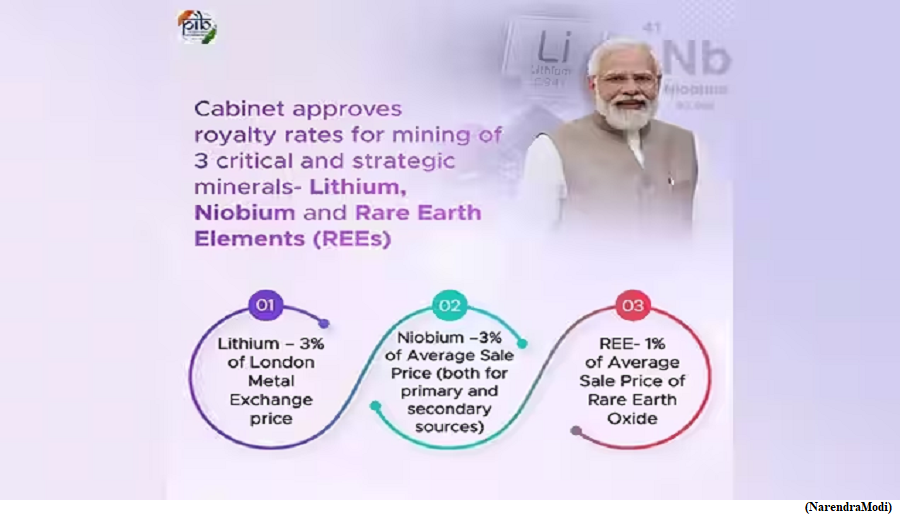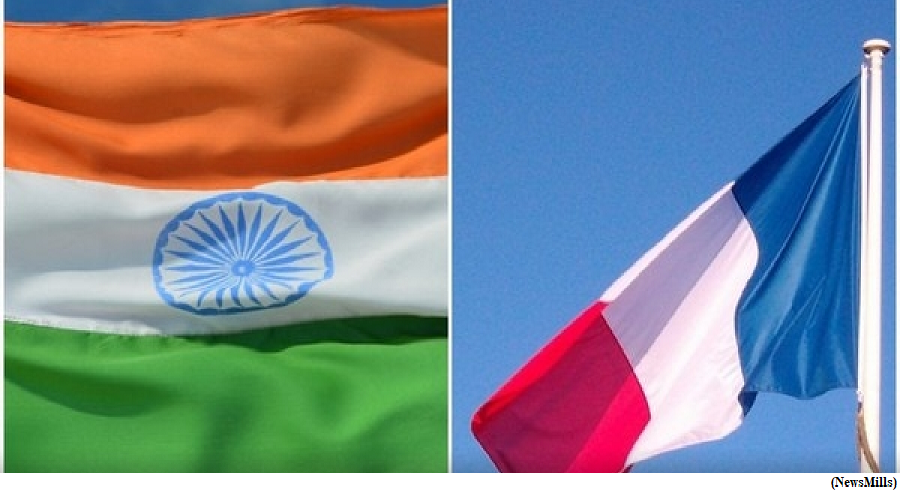Cabinet approves royalty rates for mining of three critical and strategic minerals- Lithium, Niobium and Rare Earth Elements (REEs) (GS Paper 3, Economy)

Why in news?
- The Union Cabinet recently approved amendment of Second Schedule of the Mines and Minerals (Development and Regulation) Act, 1957 (‘MMDR Act’) for specifying rate of royalty in respect of 3 critical and strategic minerals, namely, Lithium, Niobium and Rare Earth Elements (REEs).
Delisted minerals:
- Recently, the Mines and Minerals (Development and Regulation) Amendment Act, 2023 was passed by the Parliament, which has come into force from 17th August, 2023.
- The Amendment delisted six minerals, including Lithium and Niobium, from the list of atomic minerals, thereby allowing grant of concessions for these minerals to private sector through auction.
- It provided that mining lease and composite license of 24 critical and strategic minerals (which are listed in Part D of the First Schedule of the Act), including Lithium, Niobium and REEs (not containing Uranium and Thorium), shall be auctioned by the Central Government.
- It will enable the Central Government to auction blocks for Lithium, Niobium and REEs for the first time in the country. Royalty rate on minerals is an important financial consideration for the bidders in auction of blocks.
- Further, manner for calculation of Average Sale Price (ASP) of these minerals has also been prepared by the Ministry of Mines which will enable determination of bid parameters.
Second Schedule of the MMDR Act:
- The Second Schedule of the MMDR Act provides royalty rates for various minerals. Item No.55 of the Second Schedule provides that royalty rate for the minerals whose royalty rate is not specifically provided therein shall be 12% of the Average Sale Price (ASP).
- Thus, if the royalty rate for Lithium, Niobium and REE is not specifically provided, then their default royalty rate would be 12% of ASP, which is considerably high as compared to other critical and strategic minerals.
- Also, this royalty rate of 12% is not comparable with other mineral producing countries. Thus, it is decided to specify a reasonable royalty rate of Lithium, Niobium and REE as below:
- Lithium – 3% of London Metal Exchange price,
- Niobium –3% of Average Sale Price (both for primary and secondary sources),
- REE- 1% of Average Sale Price of Rare Earth Oxide
Significance of Critical minerals:
- Critical minerals have become essential for economic development and national security in the country. Critical minerals such as Lithium and REEs have gained significance in view of India’s commitment towards energy transition and achieving net-zero emission by 2070.
- Lithium, Niobium and REEs have also emerged as strategic elements due their usages and geo-political scenario.
- Encouraging indigenous mining would lead to reduction in imports and setting up of related industries and infrastructure projects. The proposal is also expected to increase generation of employment in the mining sector.
Way Forward:
- Geological Survey of India (GSI) has recently handed over the exploration report of REE and Lithium blocks. Further, GSI and other exploration agencies are conducting exploration for critical and strategic minerals in the country.
- The Central Government is working to launch the first tranche of the auction of critical and strategic minerals such as Lithium, REE, Nickel, Platinum Group of Elements, Potash, Glauconite, Phosphorite, Graphite, Molybdenum, etc. shortly.
Cabinet approves MoU between India and France on cooperation in the field of Digital Technologies
(GS Paper 2, International Relation)
Why in news?
- The Union Cabinet has approved the signing of the MoU between India and France.

Details:
- The MoU intends to promote closer cooperation and exchange of information pertaining to the digital technologies.
- It will mutually support each Participant’s goal to promote access to digital Technology in their country in accordance with the MoU.
Major Impact:
- Both G2G and B2B bilateral Cooperation in the field of Digital technologies will be enhanced.
- MoU envisages improved collaboration leading to employment opportunities in the field of IT.
Background:
- MeitY has been mandated to promote international cooperation in the emerging and frontier areas of information Technology under bilateral and regional framework of cooperation.
- In its endeavour to foster international cooperation in the field of digital technologies, MeitY has entered into MoUs/Agreements with counterpart organizations/agencies of various countries on bilateral or multilateral for a.
- In this changing paradigm, there is an imminent need for exploring business opportunities and attracting investment in the digital sector through such mutual cooperation.
Indo-French cooperation:
- India and France are long-standing strategic partners in the Indo-European region. India and France are committed to nurture a thriving digital eco system and building collaboration that empower their citizens and ensure their full participation in the digital century.
- Based on the Indo-French Road map on Cyber security and Digital Technology announced on 2019, India and France are pursuing an ambitious bilateral cooperation on advanced digital technologies, particularly in the fields of supercomputing, cloud computing, Artificial Intelligence and quantum technologies, including in the framework of the Global Partnership on Artificial Intelligence (GPAI).
Cabinet approves establishment of an autonomous body Mera Yuva Bharat
(GS Paper 2, Governance)
Why in news?
- The Union Cabinet has approved establishment of an autonomous body Mera Yuva Bharat (MY Bharat).
- It aims to serve as an overarching enabling mechanism powered by technology for youth development and youth led development and provide equitable access to youth to actualize their aspirations and build Viksit Bharat across the entire spectrum of the Government.

Impact:
- The primary objective of Mera Yuva Bharat (MY Bharat) is to make it a whole of Government platform for youth development.
- Under the new arrangement, with access to resources & connection to opportunities, youth would become community change agents and nation builders allowing them to act as the Yuva Setu between the Government and the citizens.
- It seeks to harness the immense youth energy for nation-building.
Details:
- Mera Yuva Bharat (MY Bharat), an autonomous body will benefit the youth in the age-group of 15-29 years, in line with the definition of ‘Youth’ in the National Youth Policy.
- In case of programme components specifically meant for the adolescents, the beneficiaries will be in the age-group of 10-19 years.
The establishment of Mera Yuva Bharat (MY Bharat) would lead to:
- Leadership Development in the Youth:
- Improve the leadership skills through experiential learning by shifting from isolated physical interaction to programmatic skills.
- Investing more in youth to make them social innovators, leaders in the communities.
- Setting the focus of the Government on Youth Led development and to make the Youth “active drivers” of development and not merely “passive recipients”.
- Better alignment between youth aspirations and community needs.
- Enhanced efficiency through Convergence of existing programmes.
- Act as a one stop shop for young people and Ministries.
- Create a centralized youth data base.
- Improved two-way communication to connect youth government initiatives and activities of other stakeholder that engage with youth.
- Ensuring accessibility by creating a phygital ecosystem.




